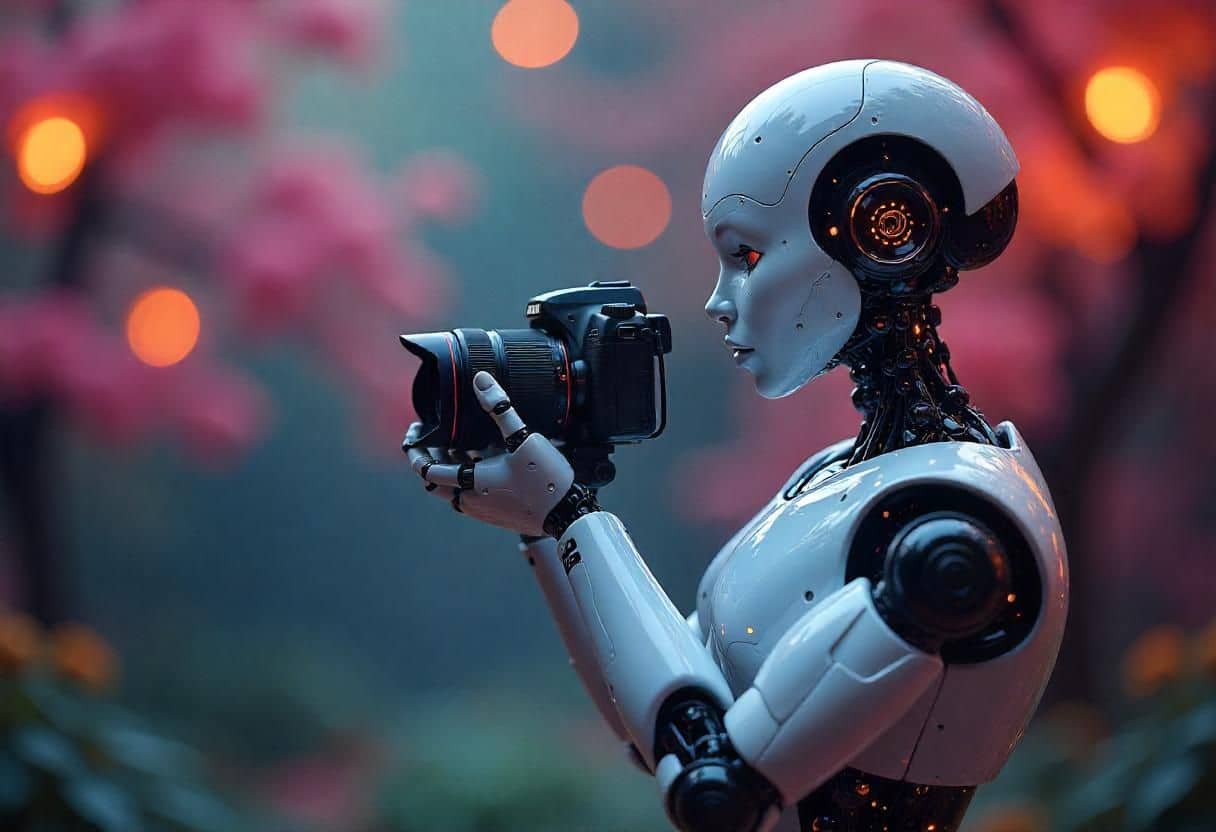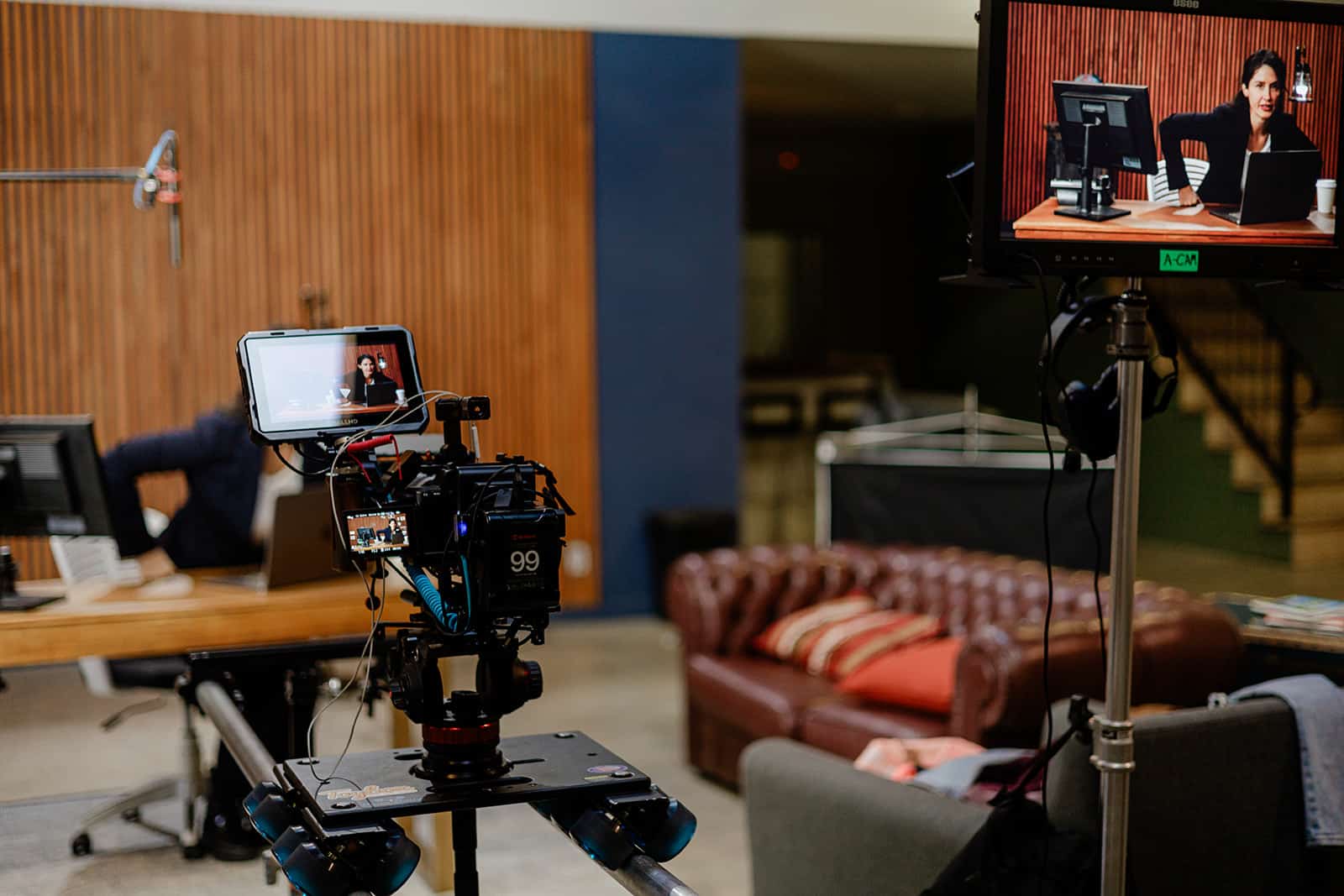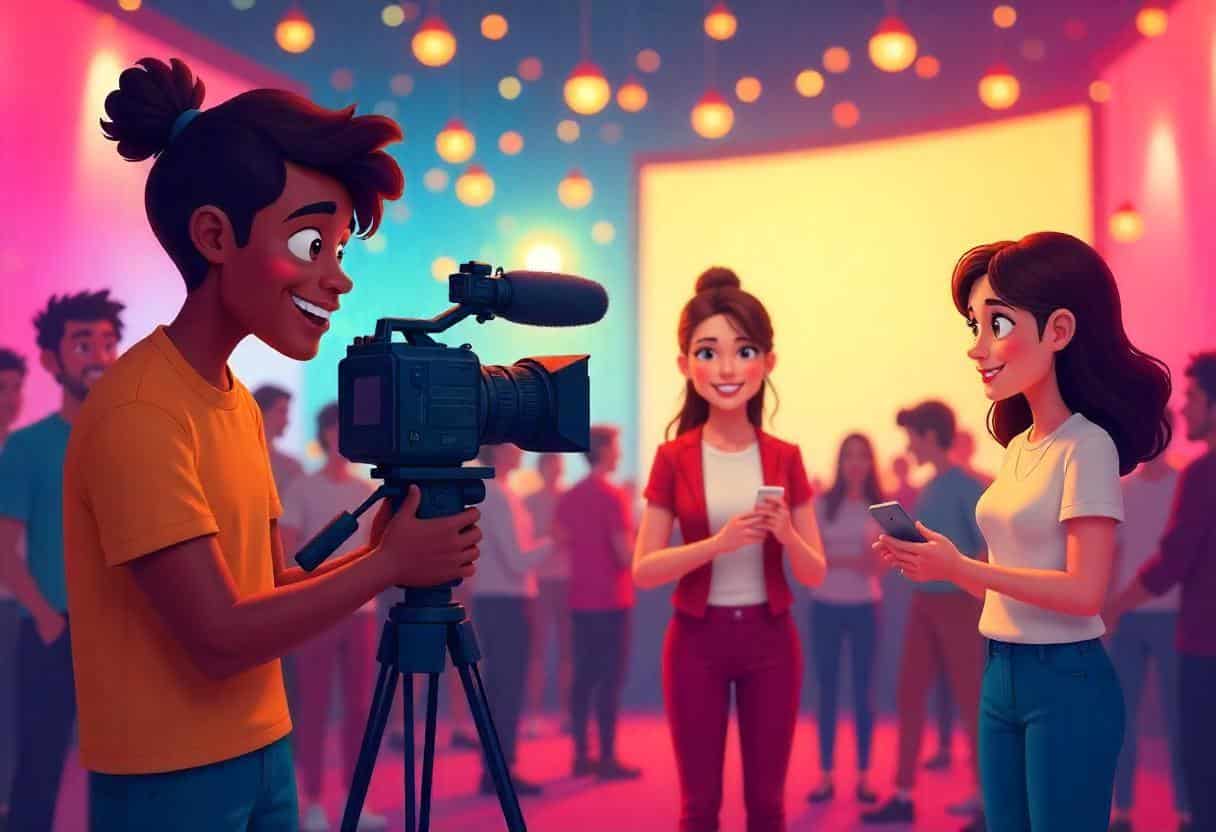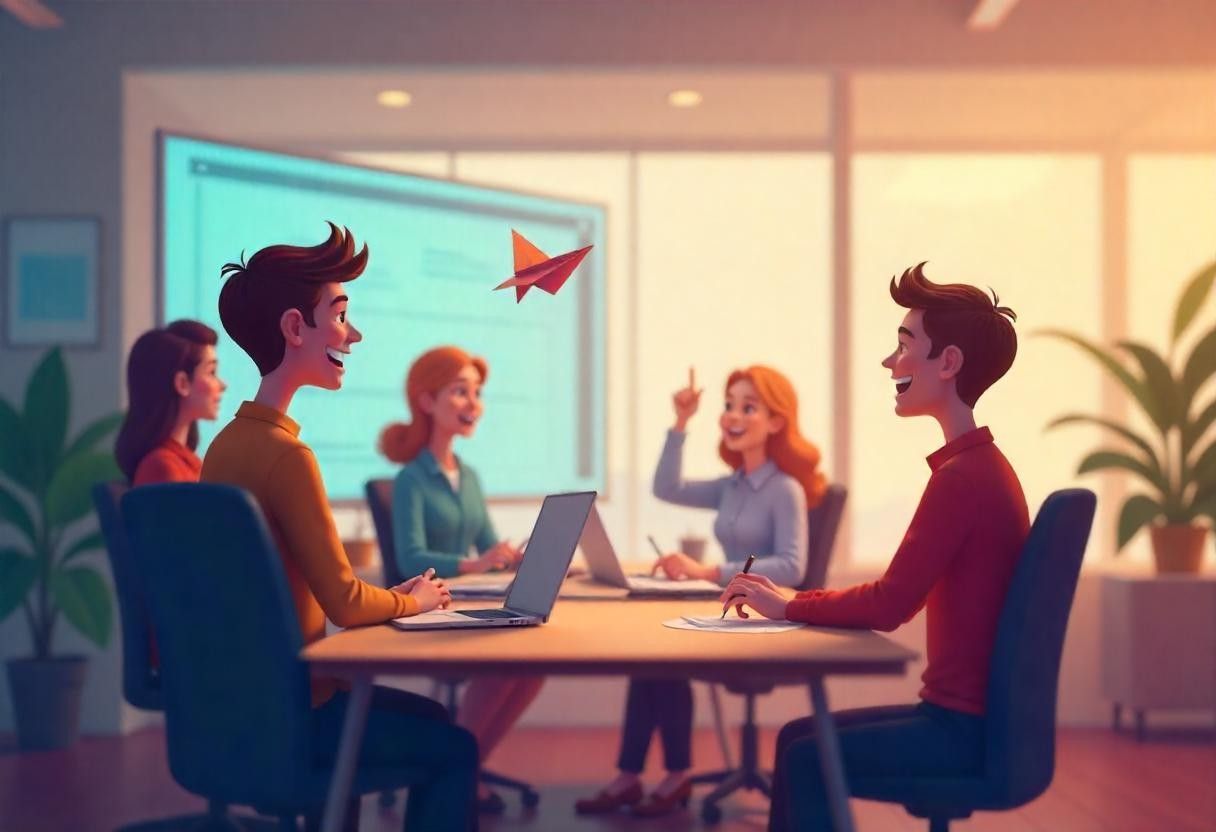Artificial Intelligence has gone from BTS to Center Stage.
It took almost 100 years but the spotlight is finally shining on the AI. The tool is stealing the show in video production.
Now, our filmmaking has an all-rounder co-director/producer/editor who never sleeps.
Tech has always brought something new to the video industry.
Be it the intro to:
- Color films
- HD camera
- CGI
- Drone cinematography
All helped shape the content creation process. BUT AI!
It’s rewriting the entire playbook. From generating ideas and scripts to automating editing and adding visual effects. All these are working for AI to transform the video production industry.
That’s why-
43% of producers believe that AI has a positive impact on the creative industry. [Source: Vidjet]
The Evolution of AI in Video Production
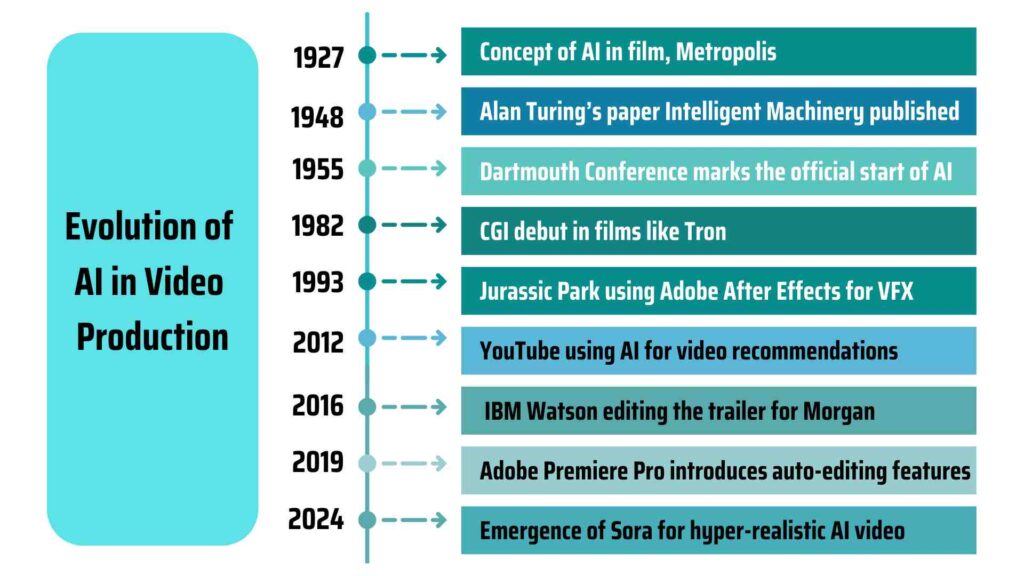
Just like we have transformation stories, Artificial Intelligence has them too.
Its roots go back as deep as the 20th century.
Early Beginnings: The 20th Century
The idea of machines thinking like humans first popped up in the 1927 film Metropolis. In this movie, Maria, a robot, was created to look and act like us.
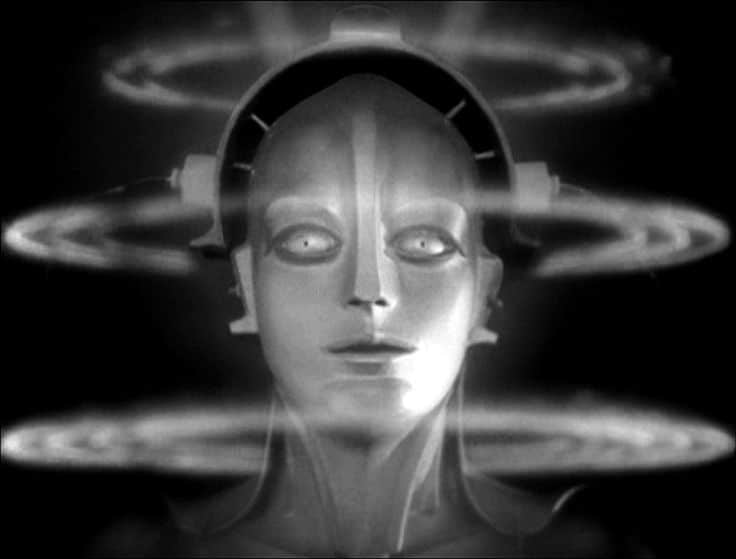
[Image: Still from Metropolis, 1927]
This was one of the earliest videos to touch the concept of AL, though, it was just a story.
Such glimpses of the reel world made an impact on the real world. Although AI didn’t exist then, such film visions inspired its integration into daily life.
The Mid-20th Century Breakthroughs
AI as an actual field started with a 1948 manifesto.
Alan Turning wrote a seminal paper “Intelligent Machinery”. It suggested machines could imitate human behavior.
Around the same time, McCulloch and Pitts introduced neural networks. These systems helped machines learn- just like how our brains work.
They worked like a foundation for modern AI.
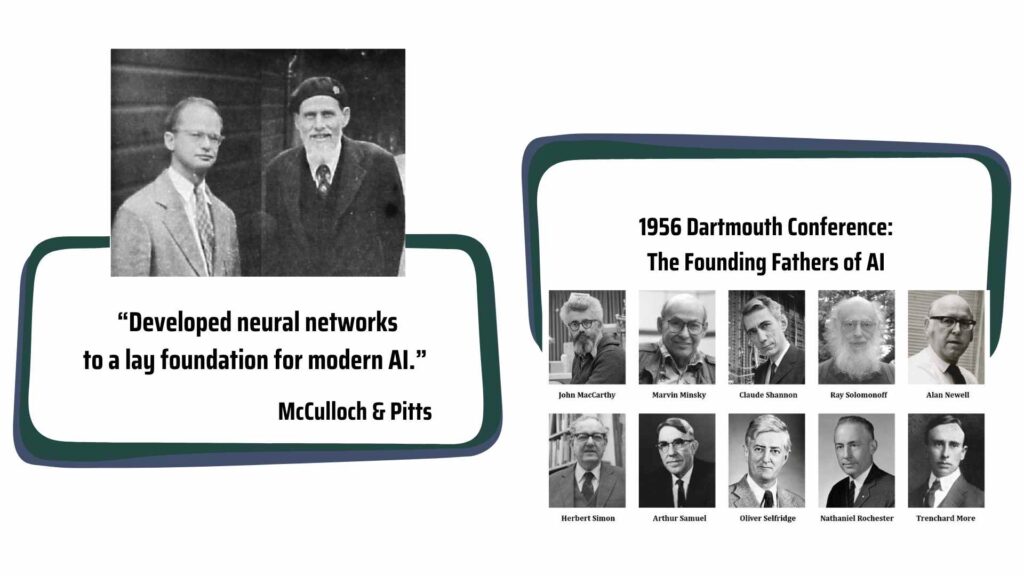
Then in 1955. The official AI introduction happened. The term Artificial Intelligence was first uttered at a conference at Dartmouth College.
Scientists started exploring the field more. They wanted to build machines that could think and act like us.
This set the stage for AI’s growth. However, the practical application in video production was still decades away.
AI’s Baby Steps In Video Production
The late 20th century.
That period saw the rise of AI in video production.
Computer-generated imagery (CGI), a technology of blending real footage with digital effects, made its debut.
One of the first films that used CGI was Tron in 1982.
Fast forward to 1993. Software like Adobe After Effects appeared. It allowed filmmakers to add advanced visual effects.
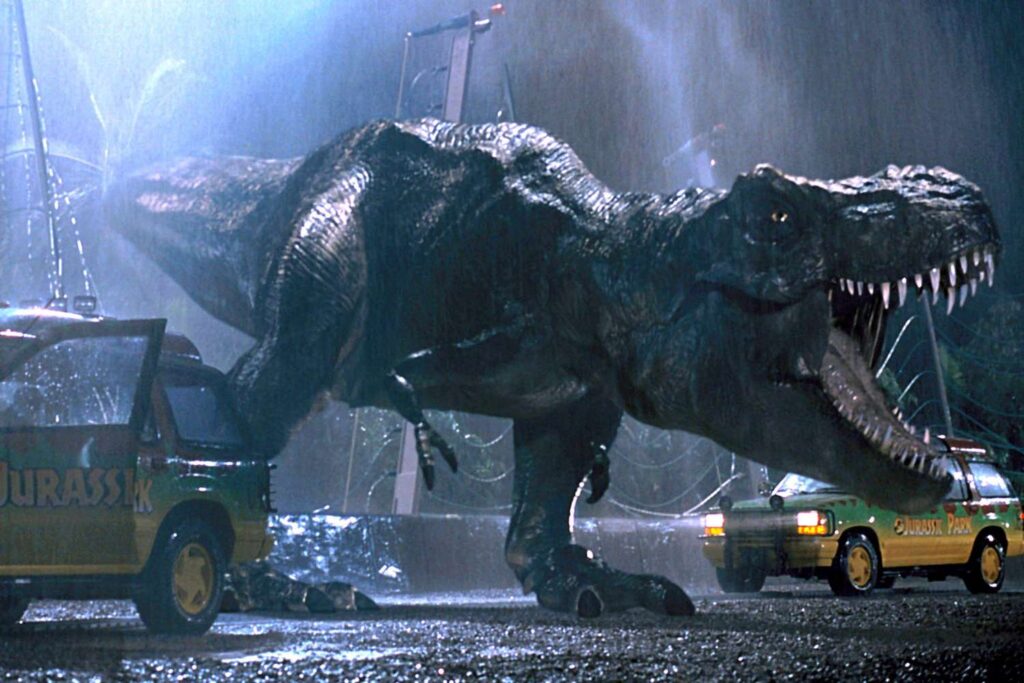
[Image: Still From Jurassic Park, 1993 | Use of AI]
For instance, the Jurassic Park team used it first to create realistic visual effects (VFX). Although super simple, it transformed the film industry.
This marked the beginning of AI-assisted video editing.
Because of their convenience, it opened doors for more complex use of AI in video production.
AI Explosion in the 21st Century
The 21st witnessed the boom of AI in the video industry.
By 2010, machine learning algorithms could analyze video content.
One prominent example is YouTube.
It started using AI in 2012 to recommend videos based on user behavior.
Several AI tools started popping up for video production.
In 2016, IBM Watson, an AI tool, helped make the first AI-edited movie trailer for Morgan.
Then, Adobe Premiere Pro in 2019 came with AI-powered auto-editing features. It helped save video producers hours of work.
More tools like NVIDIA’s GauGAN and OpenAI’s DALL·E helped turn simple drawings into photorealistic landscapes.
By 2024, Sora AI arrived to let people create hyper-realistic content within a few minutes. It simulates different aspects and streamlines the video editing processes with ease.
Key AI Technologies Transforming Video Production
AI-Powered Pre-Production
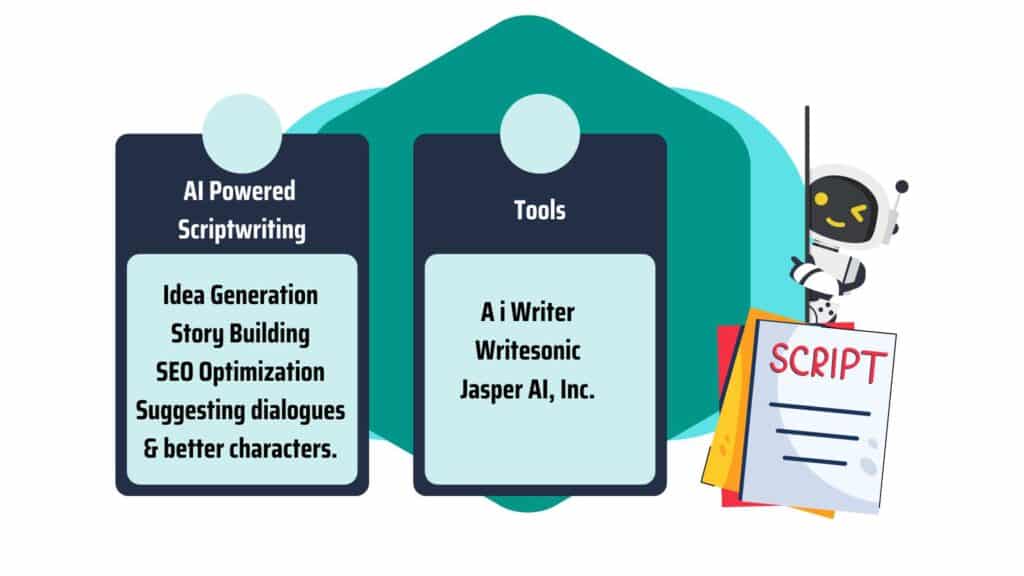
AI In Scriptwriting
The trendy ones.
Such tools are changing the pattern of video production. They help scriptwriters-
- Come up with ideas
- Build stories
- Pen down stories with ease
The AI Scriptwriting tools also have features like-
- Suggesting dialogues
- Creating Twists
- Improving character details
- Optimizing scripts for SEO
By reviewing the information provided, the AI tools provide those perks.
This saves time and boosts creativity in the pre-production stages.
Case Studies like Sunspring 2016 and Zone Out 2022 are great examples. In both movies, the use of AI had a transformative impact on scriptwriting.
It helped engage audiences and open new possibilities for storytelling.
AI Scriptwriting Tools
- Ai Writer
- Writesonic
- Jasper AI, Inc.
- Rytr LLC
- Backstory Generator
AI Video Generators For Production
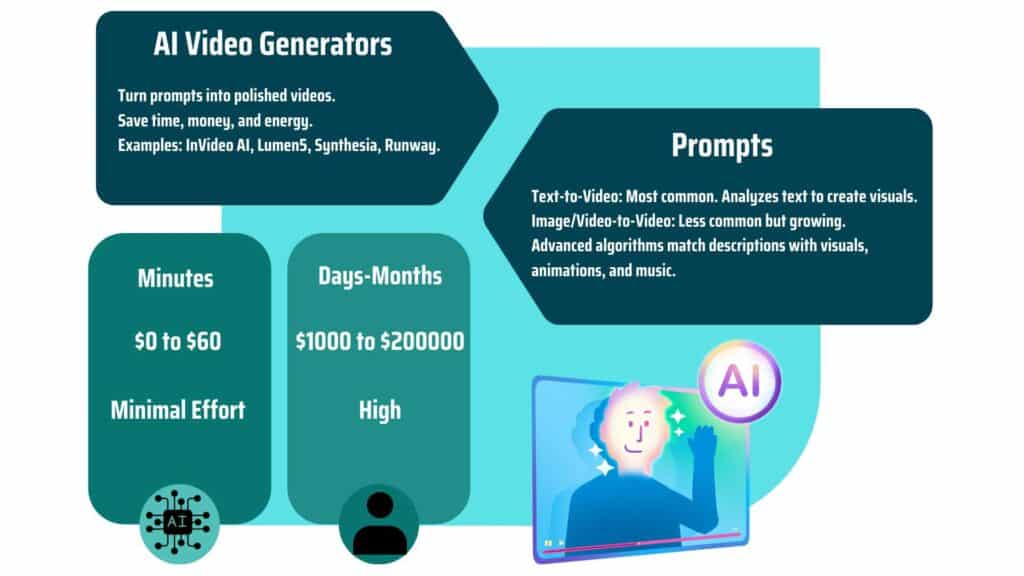
A standout innovation!
AI video generators are like the popular heroes in video production. The tools can take anything as “prompts” and create a polished video– with little effort on your part.
This includes: text, images, and even a few video clips!
Prompt-to-Video Generation
Out of all, Text-to Video is the most common!
Just type any random sentence “A cat flying a paper airplane through a flock of confused pigeons.” Watch it turned into a full video.
That’s the power of AI Video Generator from text. They:
- Use advanced algorithms
- Analyze your text
- Create visuals that match the description
There can be some blunders. But learning how to get the proper content from prompts is fun too.
Platforms like InVideo AI and Lumen5 lead the charge. They let you create pro-looking videos within minutes. All you have to do is: input the right text.
Such a tool assesses the words and creates the whole content with animations, transitions, and music.
You can expect the same results through image-to-video generators or video-to-video tools. All these work quite similarly, although these two aren’t that prevalent.
However, such AI Video Generators are video editors’ favorite. They save time, money, and energy.
| Factors | AI Video Generators | Human Making Videos |
| Time | Minutes | Days to Months |
| Money | $0 to $60-100 | $1000 to $200,000 |
| Energy | Minimal | High |
See? That’s why it’s a big deal.
One study highlights that-
“The future of AI Video Generators seems bright. It enhances creativity and makes video production easier across different fields.”
AI Video Generator Tools
Not all are the same. Some tools are free while others have paid premium features.
Free “AI video generator” options like Pictory and Lumen5 can be beginner favorites. They have basic video production features that can help them grow.
Sora, Synthesia, and Runway are the paid options. They have advanced features that are suitable for video production companies and expert editors.
Comparison of Top 5 AI Video Generator Tools
| Tool | Free/Paid | Key Features | Ease of Use | Output Quality |
| InVideo | Paid (Free Trial) | AI text-to-video, smart templates | Easy | High |
| Lumen5 | Free (Paid Options) | Video maker with text, image, & video | Very Easy | Medium |
| Pictory | Free (Paid Options) | AI transcription, highlights, clips | Easy | High |
| Synthesia | Paid | AI avatars, voice synthesis | Moderate | Higher |
| Runway | Paid (Free Trial) | AI tools for motion, style, generation | Moderate | Higher |
| Sora | Paid | Complex scene generation, realistic video creation. | Varied | Highest |
AI in Post-Production
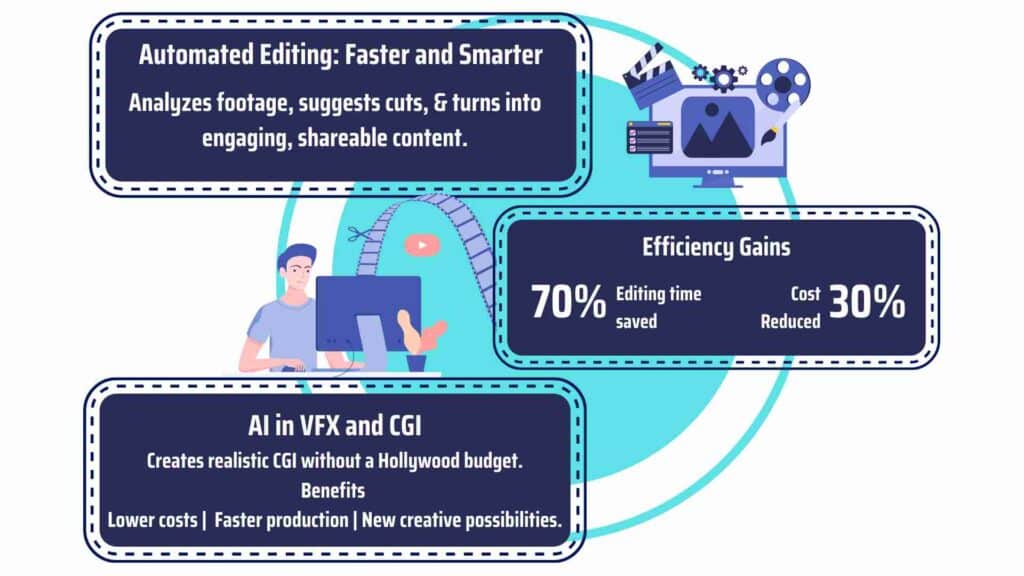
Once you’re done with shooting, the editing schedule emerges. This is daunting but not when you have AI tools.
Such software has features that cut footage, enhance visuals, and even generate CGI. All these are only from text prompts.
This speeds up workflows, reduces costs, and lets you focus on more creative stuff like storytelling.
Automated Editing
Editing footage is a big pain.
The Reddit users, who are also editors, say-
“It can take 2 to 10 hours to edit a video.” This can vary based on:
- Complexity
- Type
- Length, and
- Expertise
AI makes things easier. How?
Automated Editing software evaluates your footage. Then, it auto-suggests cuts based on certain criteria- like best scenes or emotional moments.
Let’s take OpusClip for instance.
It uses AI to:
- Analyze your raw footage
- Identify highlights
- Cut the footage and
- Turn the content into shareable clips
This is highly useful when it comes to super-long videos. Editing even 5-hour-long content becomes easy.
The tools can highlight the key takeaways and create a 2-minute recap video from the footage. This eventually helps save time while ensuring you get an engaging output.
BytePlus, an AI software company says that-
“AI-powered editing can reduce video editing time by up to 70%.”
On the other hand, a case study on OpusClip shows that-
“The tool can make video description processing cheaper by 30%” It means editors can add descriptions more efficiently, quickly, and at lower costs!
Visual Effects and CGI
AI is creating ripples in visual effects (VFX) too.
The advanced techs in software can bring you realistic CGI. Runway’s Gen-2 and Gen-3 Alpha models are two prominent examples in this case.
They can turn simple text prompts into high-quality video clips.
A study even mentions that-
“AI in VFX can lower costs, speed up production, and create new artistic options.”
Want a dinosaur flying over the city? Just type and AI will create it for you.
This is a big win for the video production team. Particularly, indie filmmakers with limited resources can exploit it properly.
Because the AI tool ensures a big impact even on small projects. You don’t need a large studio budget anymore to compete with Hollywood blockbusters.
AI will be there to make it easy for you to enter the cinematic world so you can tell your stories visually.
AI-Powered Tools Shaping the Industry
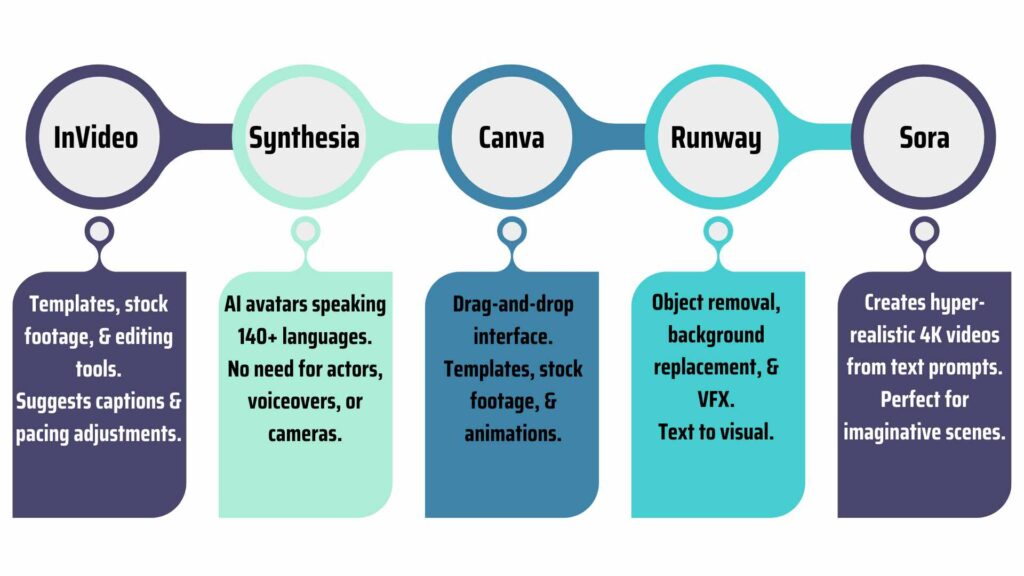
Every year, we get to see a loud appearance of new AI-powered tools. Among them, 3 are playing as main actors in the video production landscape.
InVideo AI
A popular tool among enthusiasts.
It carries a wide range of templates, stock footage, and editing features. These traits make video production a breeze.
Most users love it because it’s intuitive and affordable. Here’s a comment by a user on InVideo.
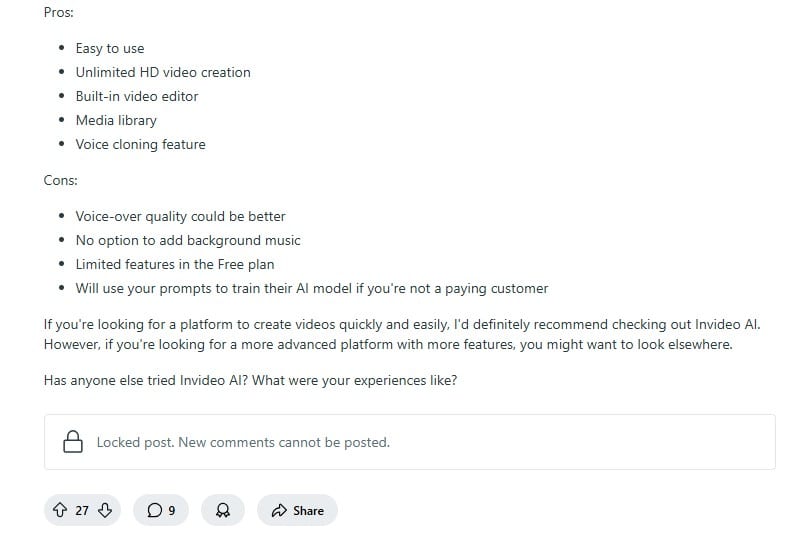
[Source: Reddit]
It’s great for social media ads, promo videos, and YouTube content. You don’t need to be a video expert to use it.
Plus, the AI can suggest improvements like-
- Adding Captions
- Adjusting the pacing
These two can help make the video more engaging.
Synthesia AI
A revolution in the AI industry.
The main weapon is its avatar technology. This is taking video production to a whole new level.
The avatars can-
- Deliver presentations
- Explain complex concepts
- Even act as brand ambassadors
They can speak 140+ languages. This helps save time on reshoots.
They can also produce personalized training videos. You don’t need any actors, voiceover artists, or cameras.
All these make the tool convenient and cost-saving. Plus, it works to enhance:
- Engagement
- Scalability
- Positive Results
You may see it mostly in content like educational videos, explainer videos, and corporate presentations.
Canva AI Video Generator
Everyone’s favorite.
Canva is already a top pick among several designers. After it added an AI video generator, the tool made big waves.
It allows you to create videos with two simple steps:
- Drag the elements
- Drop them into a timeline
One thing that sets Canva apart is its user-friendly theme.
Don’t have previous experience with designs? You can still create a polished video in minutes since the interface is straightforward.
Marketers can get the most benefit from Canva’s-
- Vast library of templates
- Stock footage, and
- Animations
Brands can easily use them to craft content and drive results. It’s suitable for social media content, short ads, and simple animations.
Runway
Tool for creative pros.
Runway is for experts who want to push the boundaries of their imagination. The tool simplifies complex editing tasks.
For example-
You can remove objects from a video or generate unique visuals just through text.
The tools can also-
- Remove backgrounds
- Add visual effects
- Provide green screen replacement
- Generate AI content
Filmmakers, animators, and designers love it the most for its advanced features.
Sora
New kid on the block.
Sora AI has attracted individuals through different features. Despite being new, it specializes in creating hyper-realistic video scenes from simple text prompts.
Just type- “A futuristic city with flying cars”
Sora AI will make a rich, premium 4K video of it.
It’s perfect for filmmakers, advertisers, and content creators. It pulls the ones who want to bring their wildest ideas to life.
Benefits of AI Integration in Video Production
So why should brands, video production companies, or any creators add AI to video making?
Because of these benefits-
Efficiency and Cost Reduction
AI is a time-saver.
Tasks that take hours to days to complete now can be done in a few minutes.
It’s cost-efficient too. You don’t have to hire talent or need big budgets to produce videos.
The lowest cost to create content through a video production company can stand around $5000. Meanwhile, the highest AI tool may ask for is $1200/year. Then again, some can be free or budget-friendly.
Creativity and Accessibility
AI can be a good friend to aspiring creators.
Small businesses and individual artists can craft high-quality videos even if they don’t have technical skills.
Think about it:
Anyone with a smartphone and an AI tool can make powerful videos nowadays.
This shift democratizes video production and lets a wider variety of voices and stories emerge.
AI tools also give you endless creative options like:
- Suggesting designs
- Offering templates, and
- Providing feedback on video performance
They help you take risks and innovate.
Challenges and Ethical Considerations
Deepfakes and Misinformation
The big bad news about AI is that creating deepfakes has become easier.
These are the content that looks real but are fake. They can-
- Spread false information
- Damage reputation
- Manipulate public opinion
It raises ethical concerns and presents a huge challenge for society. Because fake news can easily confuse people about basic facts and make them believe it’s true.
Public figures are one of the sufferers. AI-generated videos of them saying things they never said.
For example-
An AI video went viral in Feb 2025 where celebrities were seen protesting Kanye West‘s antisemitism.
However, the video was created without their permission. This makes the whole thing illegal. Then again, it was tricky to take action against the creator since he was from another country.
The real Scarlett Johansson objected to the deepfake video. She says-
“The potential for hate speech multiplied by AI is a far greater threat. We must call it out.”
To combat this, different strategies are emerging too like-
- AI detection tools like Deepware Scanner can detect AI videos.
- Watermarking AI content can improve transparency.
- Adobe Content Authenticity app helps protect work from AI use.
Job Displacement Concerns
AI is automating tasks like editing and animation.
This is a huge convenience. Then again, it also raises fears about job losses in the video production industry.
Here, human editors and animators are the first victims.
A Goldman Sachs report highlights that-
“AI could take away around 300 million jobs.”
That said, AI could never replace human creativity no matter how smart it is.
An AI tool can come up with stories. But they won’t have the emotions a human can add.
So every automated work needs human for-
- Storytelling
- Emotional depth
- Creative direction
To balance it- we can focus on reskilling workers.
Different companies train employees to use AI tools. This helps enhance their work and makes both the intelligence (Artificial and Human) effective.
Adobe is already doing that. It offers training programs for creative people to learn AI tools like Firefly.
This ensures humans and AI work together, not against one another.
The Future of AI in Video Production
Emerging Trends
Virtual Production and Augmented Reality
AI can create realistic virtual sets and backgrounds.
Filmmakers and video production companies can use AI-powered AR tools to add digital elements to real-world scenes.
This can make production quicker, cheaper, and more convenient.
Facial and Voice In AI
AI can create realistic faces and voices through different tools.
They are great for dubbing. Plus, they can bring old actors back to life and create digital doubles for stunts.
Video Captioning and Translation
AI-powered speech recognition and natural language processing techniques are improving.
This can make video captioning and translation more precise.
It’s highly beneficial for individuals with hearing impairments.
Plus, it can ease multilingual video content distribution.
Prediction
- Synthesize video content close to human-level quality.
- Enhancement of video quality in real-time with upscaling resolution, improving color grading, and reducing noise.
- More premium visual effects by automating taste like rotoscoping, motion traction, and compositing.
- AI-driven storyboarding and pre-visualization for scripts and conceptual ideas to help directors and producers.
- AI-powered cameras and drones for optimizing framing, lighting, and camera movements in real-time.
Team Up With LocalEyes!
Yes! AI is quite a pro multi-tasker. But nothing beats a team of creative experts.
That’s where LocalEyes slide into. We make videos that look vibrant while ensuring engagement, views, conversion, and sales.
Let’s chat and see how we can bring your vision to life.
Frequently Asked Questions
How is AI changing the video production industry?
AI helps with the ideas, scriptwriting, editing, and special effects.
The tools make the process faster, cost-efficient, and more creative. This makes videos easier to produce.
How has AI changed the film industry?
AI has enhanced scriptwriting, automated editing, and enriched VFX.
This made filmmaking effective and creative which helped transform the film industry.
How AI is changing the video game industry?
AI has brought features to the video game industry.
It has created smarter non-player characters, enhanced graphics, personalized gaming experience, and streamlined development. This results in more immersive gameplay.

